Please scroll to the bottom of the page for the English version.
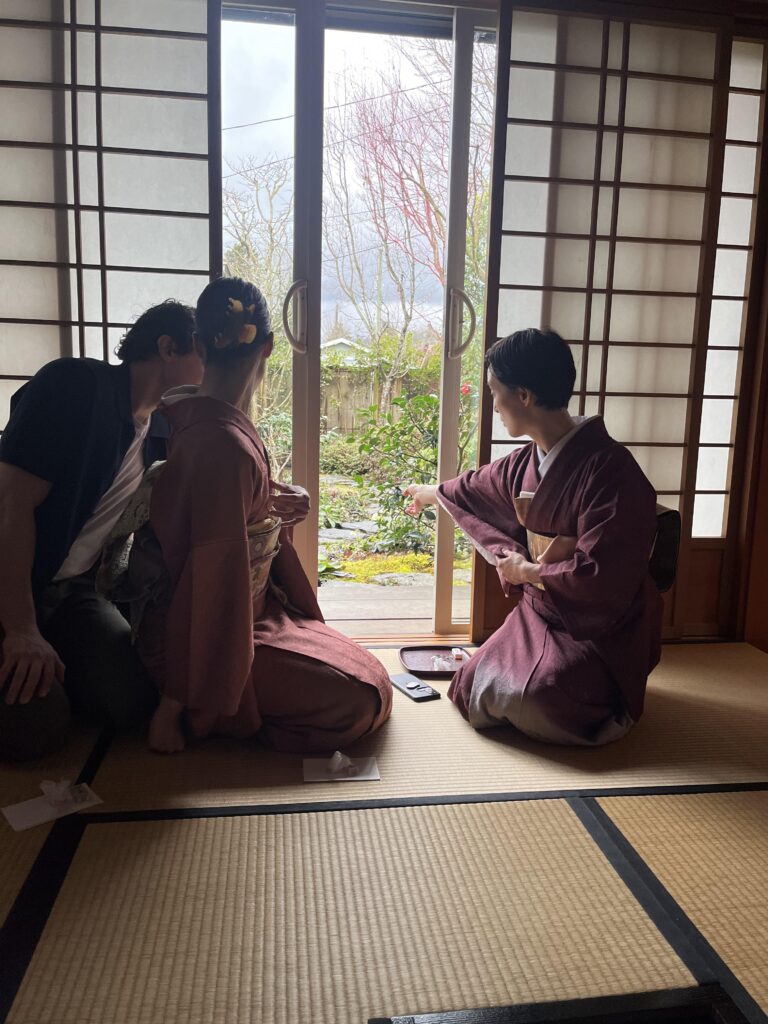
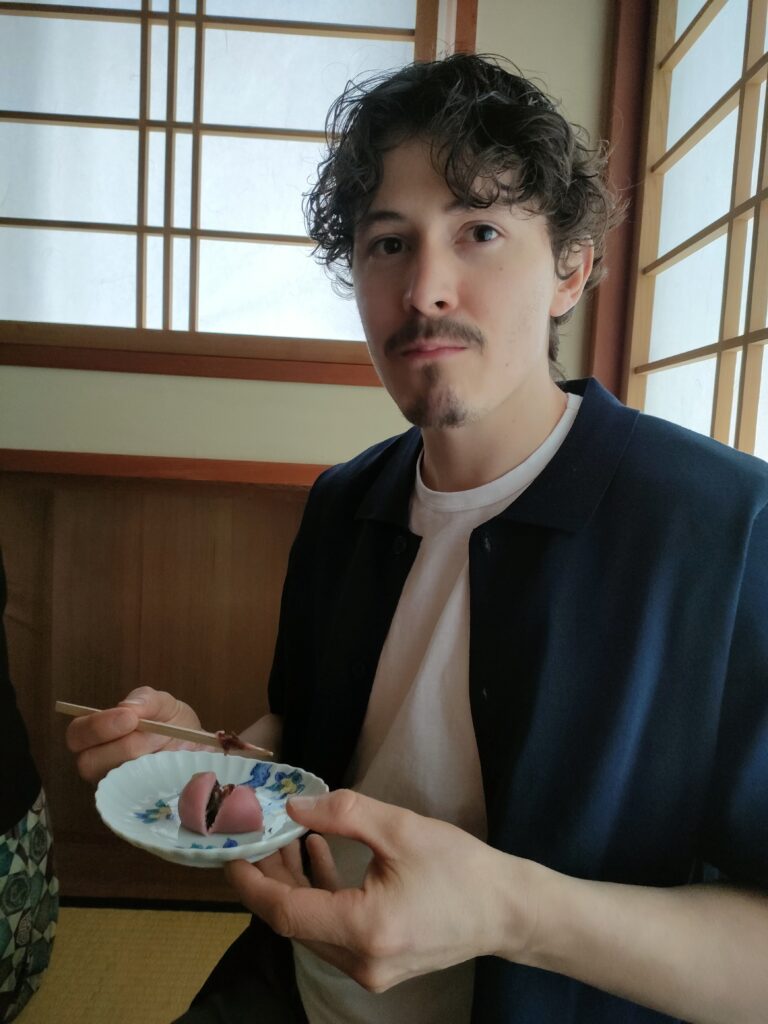
着付け教室で出会った知り合いを通じて「能登半島地震被災者の方々へのチャリティ茶会があるので、着物を来て一緒に行きませんか?」というお誘いがありました。
ノースバンクーバーの方まで足を伸ばし、お邪魔したのが「白峰庵」という裏千家茶道家高橋恭子さんがご自宅に作られた茶室。おうちの外観はノースバンクーバーらしい洋風のテイストで、一見敷地内にお茶室があるとは想像ができませんでした。
- 一期一会 in バンクーバー17
- まるで日本にいるような錯覚に陥る日本庭園と茶室「白峰庵」
- 高橋恭子さんへのインタビューで彼女の人生を紐解いていく
- 「大和撫子」は世界に誇る立派な日本人女性像
- ジャーナリスト、ライターの仕事のご依頼はこちらのフォームから
- The tea room “Hakuhō-an” at her residence in North Vancouver,Yasuko Takahashi, who spreads the culture of Urasenke sado(tea ceremony)in Canada-The ‘Yamato Nadeshiko’ is an image of Japanese womanhood that is proud worldwide-
- One moment, one meeting” in Vancouver
- The Japanese garden and tea room “Hakuhō-an” induce an illusion as if you were in Japan
- Unraveling Yasuko Takahashi’s life through an interview
- What prompted you to come to Vancouver? And what led to your stay of about 30 years?
- Meeting her husband and the birth of their two children
- She was such a fan of kimono that she obtained a license for dressing them in Japan, and in Vancouver, she encountered tea ceremony
- After mastering tea ceremony in Vancouver for over 15 years, she moved to North Vancouver and created a tea room and Japanese garden at her home
- About Yasuko-san’s tea ceremony class
- Her family and private life
- One must behave in a manner that reflects well on being Japanese
- Looking back on life, all the pieces are connected
- Yasuko-san’s future goal is?
- The ‘Yamato Nadeshiko’ is a proud and noble image of Japanese womanhood
一期一会 in バンクーバー17
完璧な美しい着物姿でお茶を点てる「白峰庵」の主である高橋恭子さんは柔らかく可愛らしく、エレガントな雰囲気をまとった方で、とても美しい日本語をお話になります。さらに流暢な英語で私のパートナーに茶道について説明する姿はとても堂々としていて、彼女の真の強さを垣間見ることができました。
その後、是非取材をさせてほしい!と連絡して改めてお邪魔して、高橋恭子さんにインタビューをさせていただきました。
まるで日本にいるような錯覚に陥る日本庭園と茶室「白峰庵」
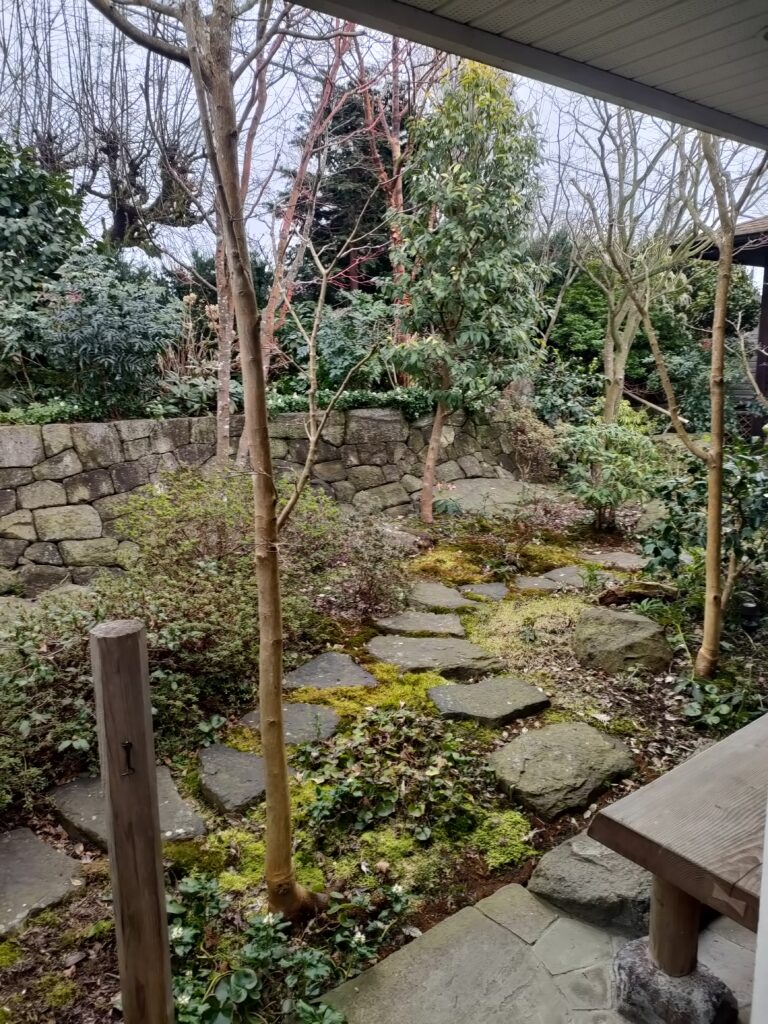
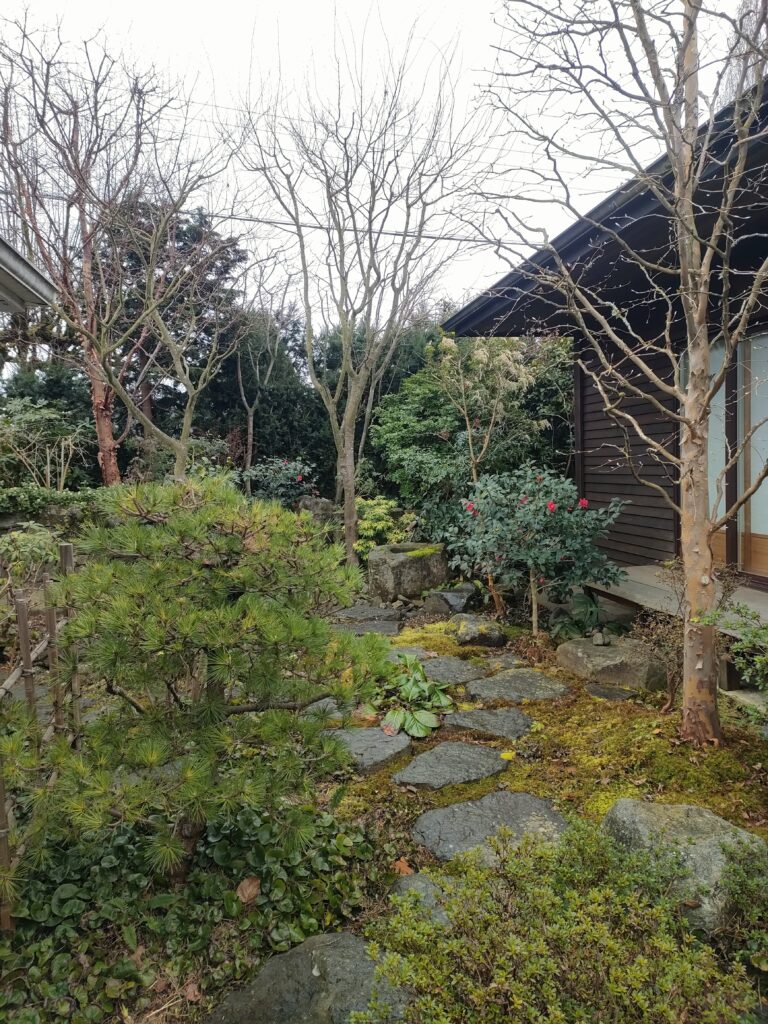
洋風の素敵なご自宅の中へ一歩足を踏み入れるとリビングの大きな窓から、美しい日本庭園が広がっていました。そこには季節のお花、飛び石や蹲があり自分がバンクーバーにいることを完全に忘れるほどの別世界(日本)が広がっています。
「にじり口」が狭い理由は?

その日本庭園を横目に先に進むと、茶室「白峰庵」が見えてきます。
「にじり口」という高さ約66cm、幅約63cmの小さな茶室への入り口は、腰を曲げてなんとか入れるほどの大きさです。
「にじり口」を初めて取り入れたのは、千利休。彼が生きた戦国時代は主従関係が非常に強い時代でしたが、「どんな身分であれ、茶室にいるときは皆が平等である」ことを示すために「にじり口」が作られました。
どんなに身分が高い人でも、刀を外して頭を下げて入らなければならないわけです。
床の間に飾られる季節のお花と掛け軸

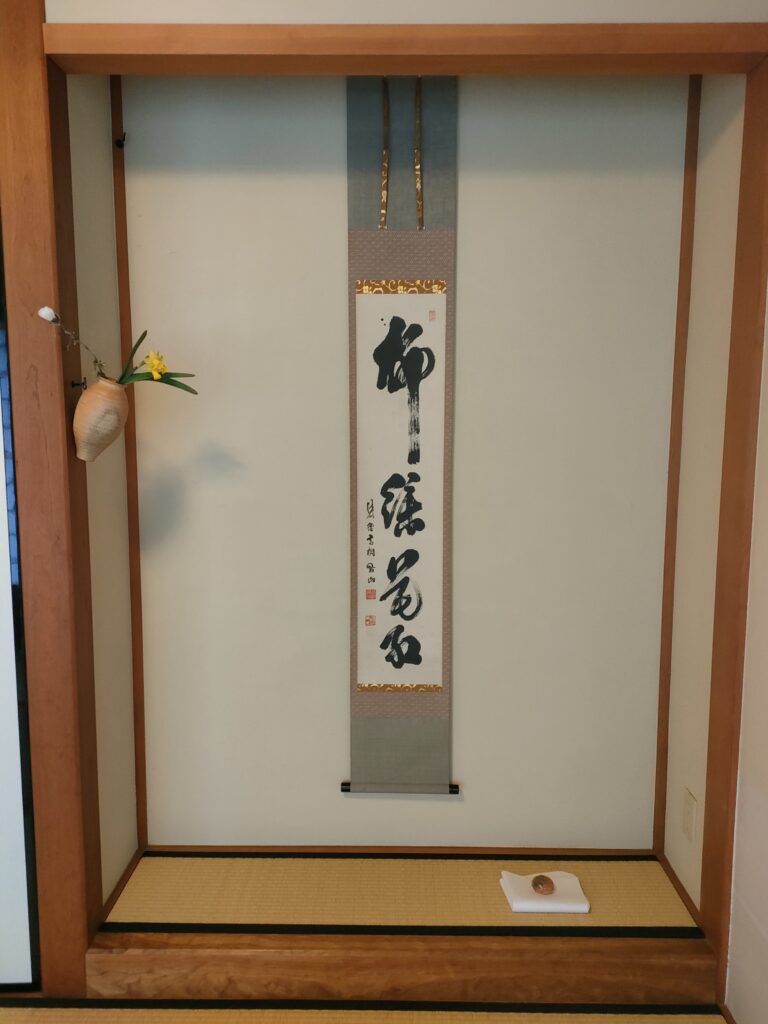
私がお邪魔した時には、恭子さんのお庭で摘んだ水仙とコブシが飾られていました。
そして掛け軸には「柳緑花紅(やなぎはみどり はなはくれない)」の文字。柳は緑、花は紅。春の美しい景色を表す言葉であり、ものにはそれぞれ個性が備わっていることのたとえです。
競争心を持つことは、時に人の成長に繋がります。ただ他者と比較することがストレスになることもありますよね。「そんな必要はないのだよ」と優しく諭してくれるような、美しい言葉です。
春の訪れを感じる和菓子と恭子さんが点てたお茶をいただく
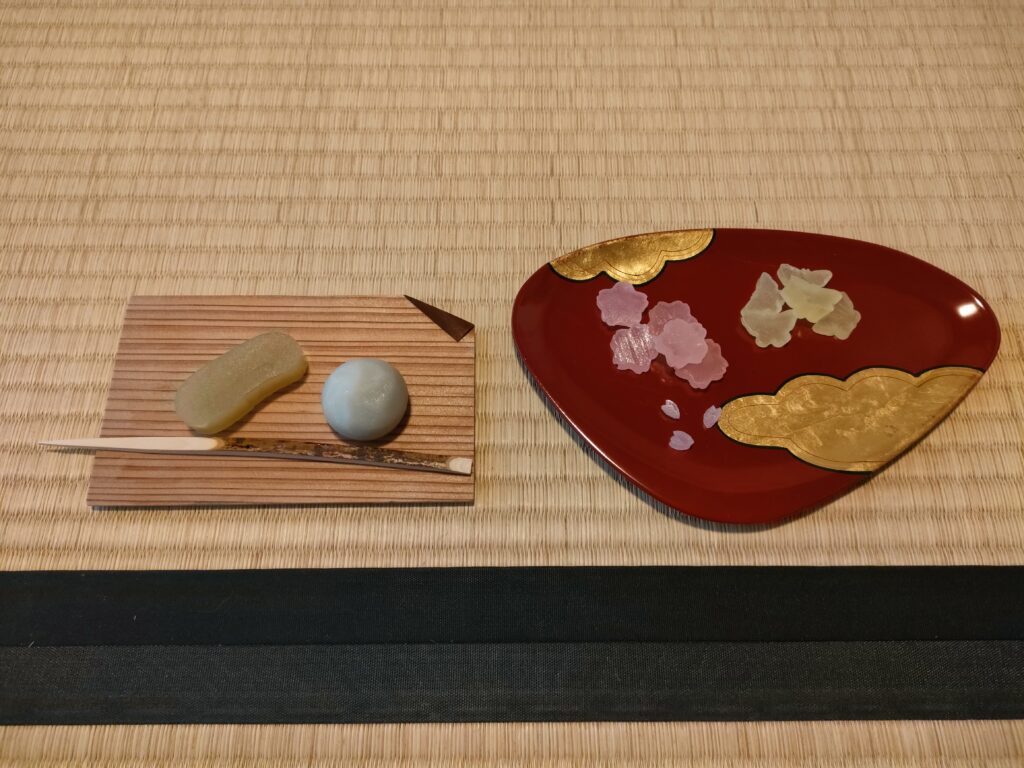
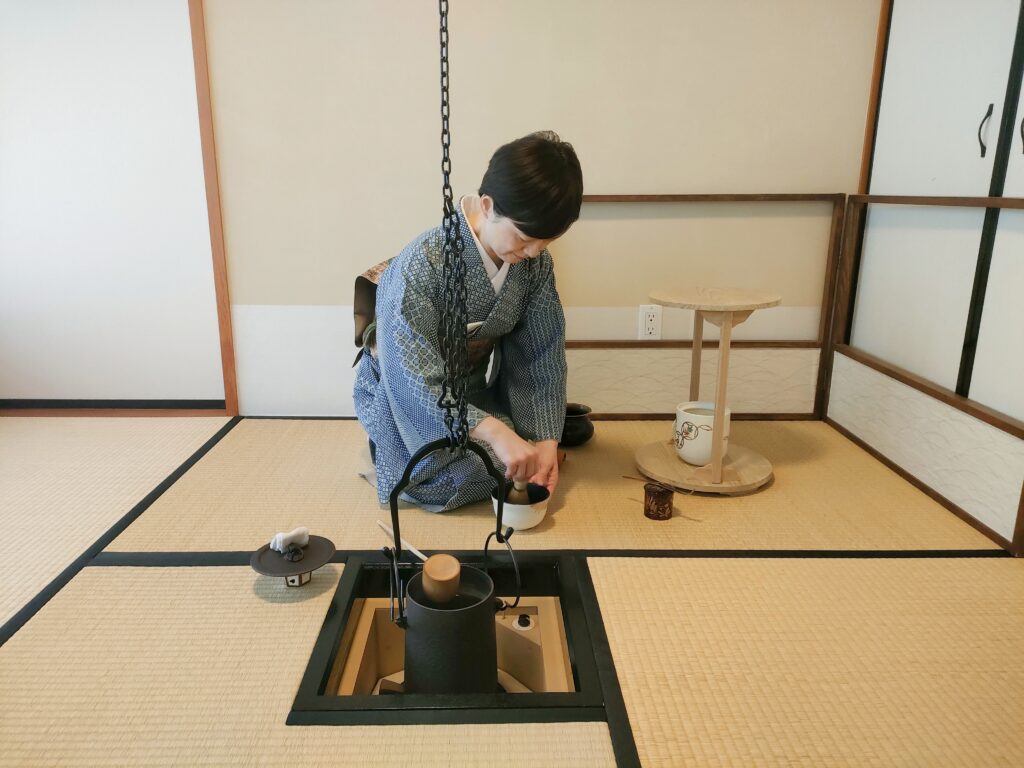
彼女のお茶を点てる所作、茶室への出入りや扉の開け閉め、話し方、立ち居振る舞いの全てが美しく、無駄がなく、エレガント。彼女が立てる音すらも美しく、完全に別世界で時間を過ごしているような錯覚に陥りました。
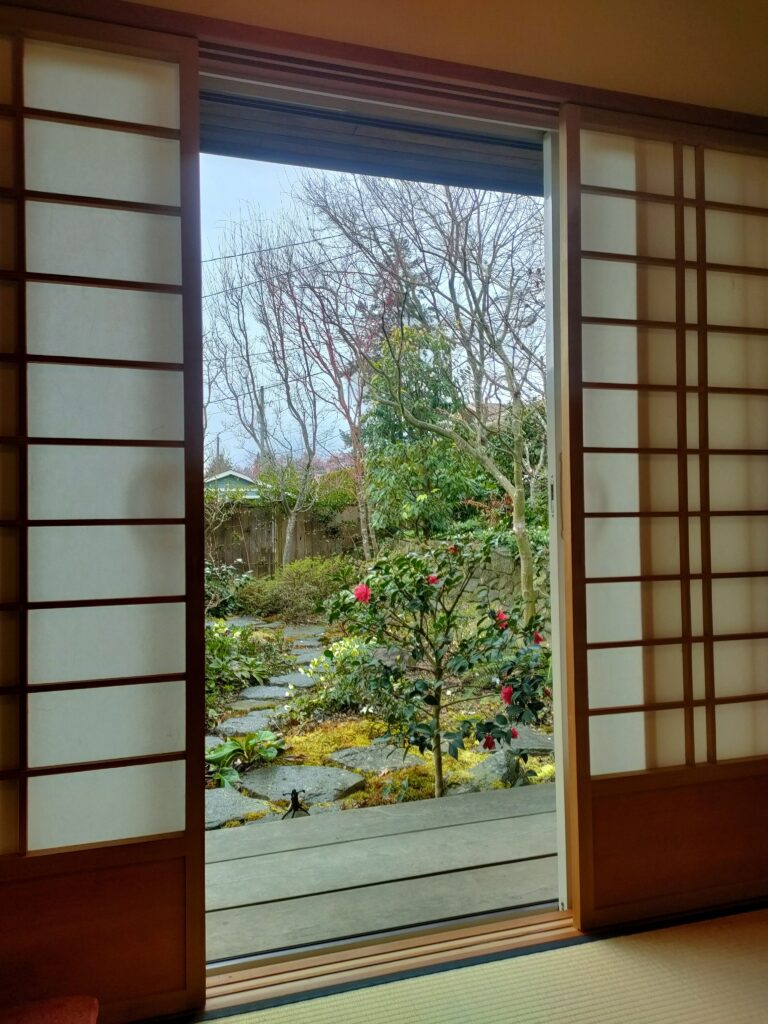
茶室からの庭園の眺めは風情があり、バンクーバーならではの曇り空が椿の赤を引き立てているようでした。
高橋恭子さんへのインタビューで彼女の人生を紐解いていく
彼女が茶道に至った経緯やバンクーバーに来た理由など、とにかく聞きたいことが山ほどあった私。
ご自宅でお茶をいただいた後、恭子さんおすすめの日本レストランに移動。
茶道家としてだけではなく、ひとりの日本人女性としてどんな方なのか、それを知りたくて沢山お話をさせていただきました。そして彼女の人生を紐解いていくことができました。
バンクーバーに来たきっかけは?そして約30年間の滞在に至った経緯
広島県ご出身。愛媛大学教育学部に行って教員免許を取ったものの先生にはならず、卒業後にバンクーバーに英語を学ぶために学生として約30年前に来た恭子さん。実は元々3ヶ月の予定だったそう。
恭子さん:「それがまさか30年になるなんて。あっというまですよ」
私:「私も元々1年の予定が、今3年目に入ったところなので、人生分からないものですよね」
旦那さんとの出会い、そして2人のお子様を授かる
当時恭子さんが生徒としてバンクーバーで通っていた学校の校長先生だった方が、未来の旦那さんになります。修学が終わり、校長先生と生徒でなくなった頃から自然と関係が始まったそうです。
付き合い始めて2年ほど経った頃に、1人目のお子様を授かり、のちにもう1人の息子さんを出産されます。上の息子さんはベトナム人の奥様とベトナムに住んでいて現在8歳のお子様がいらっしゃり、下のお子様は現在バンクーバーの大学生だそう。
日本で着付けの免状を取るほどの着物好き、バンクーバーでの茶道との出会い

学生時代に、着物の免状をとるほど着物に魅了されていた恭子さん。茶道に興味はあったものの、日本での茶道の経験はなかったそうです。
着物に惹かれたきっかけは、学生時代のホテルでのアルバイト。お客様が到着された時に着物を着てお出迎えすることがあって、その時に着物の魅力を感じたそうです。
バンクーバーで茶道に出会い、改めて日本の文化の魅力に気づく
バンクーバーに来て、たまたま訪れたUBC構内にある新渡戸記念庭園で、裏千家の茶会が開かれて参加してみたら、すぐに茶道の魅力に引き込まれて、先生に学ばせてくださいと申し出たそうです。
恭子さん:「母もお茶をしていて、そのときは着物を着てました。なので子供の頃から日本の文化は身近になりましたね。ただ若い頃って日本の文化が身近にありすぎて魅力に気づかないで、ウエスタンかぶれになりがちですよね。日本を離れることで、日本の文化の魅力に改めて気づくことができました。気がついてよかったなと思います」
バンクーバーで茶道を極めて15年経ったころノースバンクーバーに引っ越し、自宅にお茶室と日本庭園を作る
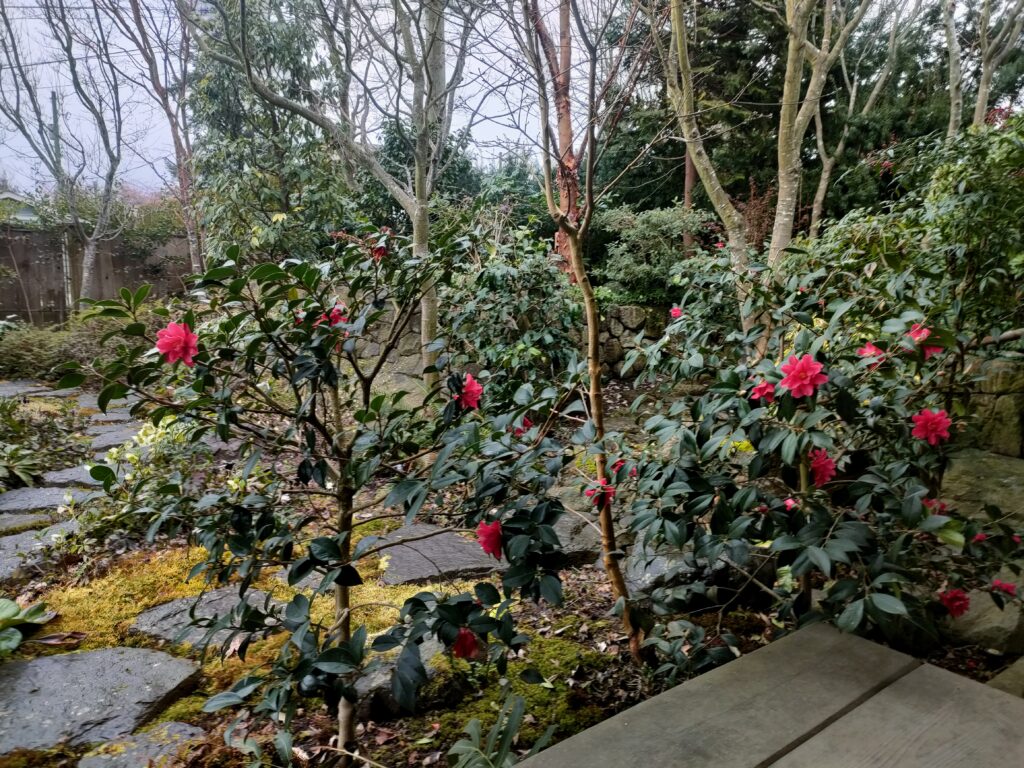
茶道教室を開くためにお茶室を作ったわけではなく、お稽古を続けて15年経ったころに「お茶名」を拝受してその一年後にこの家に引っ越し、庭にスペースがあるからお茶室を作りたいとシンプルに考えていたそうです。
そしてバンクーバー 近郊の庭師と大工さんに依頼して、作られた美しい日本庭園とお茶室。
「ノースバンクーバーの自宅にお茶室がある」ということが次第に知れ渡り、茶道教室を開いて欲しいという要望があり、それが今の恭子さんに至っています。
恭子さんの茶道教室について
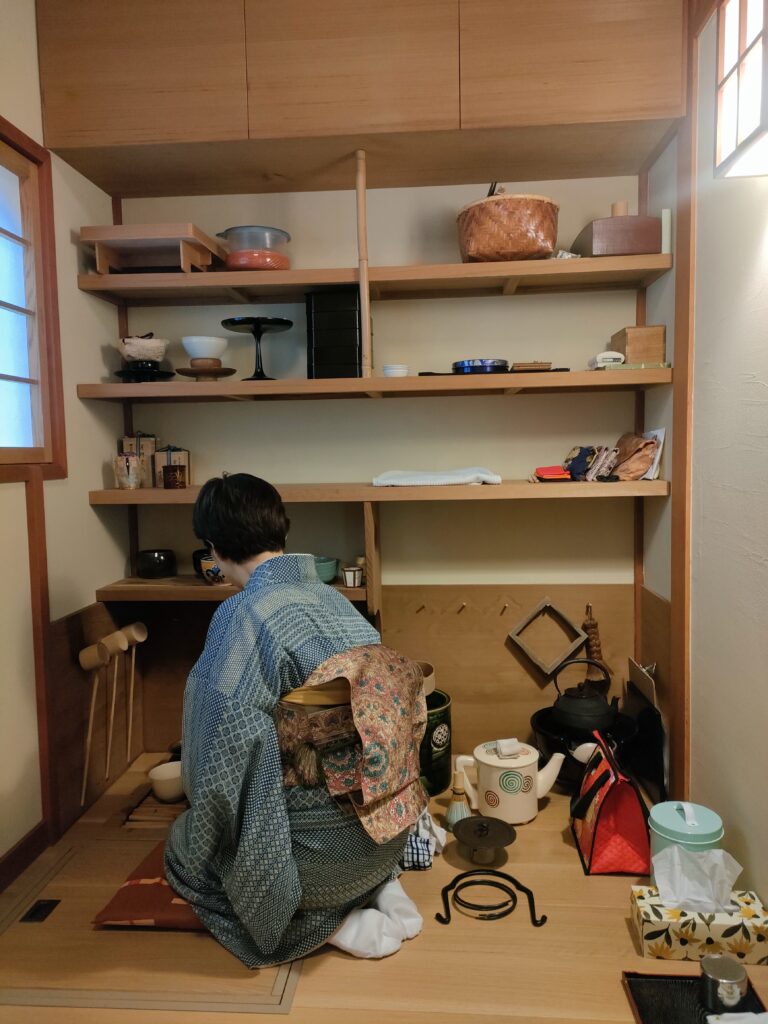
バンクーバーでお茶会を開くことと日本で開くことの違いは?
恭子さん:「日本は圧倒的に物が揃っているし、目が肥えている方が多いです。まずお茶会を開くとなると、どれだけ価値のある茶道具を持っているかというところを見られますよね。お食事込みのお茶事は、どこの料理長が作ったとか、そういうところに目が行く傾向があります。
バンクーバーには揃ってない物が多いので、なければ作るしかない。私が持っている茶道具だってすごく価値がるものをいうわけではないんですよ。
バンクーバーで茶道をすることはポジティブな面が多いですよ。あれがないこれがないはありますけど、それは補えますので」
日本の文化を英語で説明すること
私のパートナーに美しい英語の発音で流暢に、お茶の文化を説明してくださった恭子さんの姿がとても印象的でで思わず質問しました。
私:「日本の文化を英語で説明する時に、まだまだ言葉に詰まってしまうのですが、どのように進歩させましたか?」
恭子さん:「慣れです。場数を踏んで、大勢の人の前で説明をして、度胸をつけていくしかない。後は勉強しないと駄目ですね。日本語で説明できないものを英語で説明するなんて無理なので、私は暇さえあれば本読んでます」
恭子さんのご家族とプライベート
茶道以外にもスキーや旅行、朝はノースバンクーバーの森の中でジョギングをされているというアクティブな恭子さん。
ひとりの日本人女性として、母として妻としての彼女についてお聞きしたく、いくつか質問をしました。
人生で一番苦労したことは?
恭子さん:「子育て!上の子が生まれた時から反抗期っていうくらいで。
日本の大学に行かせたんですけど、学校から連絡が来て『お子様が全く学校に来ないので、このままだと落第しますよ』って。あと、お皿が飛んできたことがあります。怖かったですよ。そんなことを乗り越えたので、今は何があっても動じないですよ。
彼も今はすごくいいお父さんになりました。自分が親になって親のありがたみがわかるというか」
何をしている時が一番幸せですか?
恭子さん:「日本に帰って鄙びた温泉に使っている時です。あと一日が終わってバスソルトを入れて湯船に浸かる瞬間ですね。なんか基本浸かってますね!笑 魚座だからかな」
私:「だからお湯を使う茶道に惹かれたのかもしれないですね!」
ベストフレンドは旦那さん、彼の一番好きなところは?
私:「ベストフレンドは誰ですか?」
恭子さん:「主人。正確に言うとフレンドではないですけどね。30年以上で一番長い付き合いですから。親よりも長いので。もはや同士というか」
私:「旦那様の一番好きなところは?」
恭子さん:「一番ありがたいのは好きにさせてもらってることかな。なんでも事後報告。笑
基本的には別行動ですよ。彼は正座が20秒しか出来ないし、何年経ってもお茶の飲み方覚えないし。笑
その代わりにあなたも好きにしていいからねって。ごちゃごちゃ言わないところが好きです。お互い自由にやってるけど、信頼しあってます」
日本人として恥ずかしくない行動をしなければいけない
恭子さん:「最初にバンクーバーに来た時から感じていることは、ひとりの人間としてはもちろん、その前に日本人として恥ずかしくない行動をしなければいけない。日本代表といいますか。お茶を教える人間として、態度で示そうと」
私:「とても共感できます!昔、私の祖父が母の幼少期に、出張先のドイツから送った手紙を母が見せてくれて。そこにあった『世界に出ても恥ずかしくない立派な日本人になりませう』の一文が心に残っていて。その言葉がバンクーバーに来た理由の一つなので。海外の方を目の前にした時に英語を話せないことで、モジモジしている自分が許せなかったんです」
人生を振り返ると全てのピースが繋がっている
恭子さん:「振り返ると、全てがつながっていますよね。どれか一つでもピースがずれていたら今の私はいない。今のお家に引っ越さなければお庭もないですし、お茶室を作らなければ、茶道の講師にもならなかったので」
私:「分かります。今35歳なんですけど、年齢を重ねることでそれを体感する機会が増えて、肩の力が抜けました」
恭子さん:「そのほうが人生生きるのが楽だし、何が起こるかわからないし面白いですよね。
若い時はまだ人生が短いからわからないけど30歳すぎると、さらに50歳すぎるとそれがもっとよくわかりますよ」
恭子さんの将来の目標は?
恭子さん:「目標というか日々の生き方になりますけど、とにかく人から頼まれごとをしたら基本的に断らない。そういうことをこれからも続けていきたいです。
そして必ず人のためになることを続けていきたいですね。チャリティ茶会は年に一回は開きたいですね。必ず困っている人はいるので。
基本的には流れに沿った生き方をしていきたいです。そうしていると色々なオファーがあって面白いですよ」
「大和撫子」は世界に誇る立派な日本人女性像
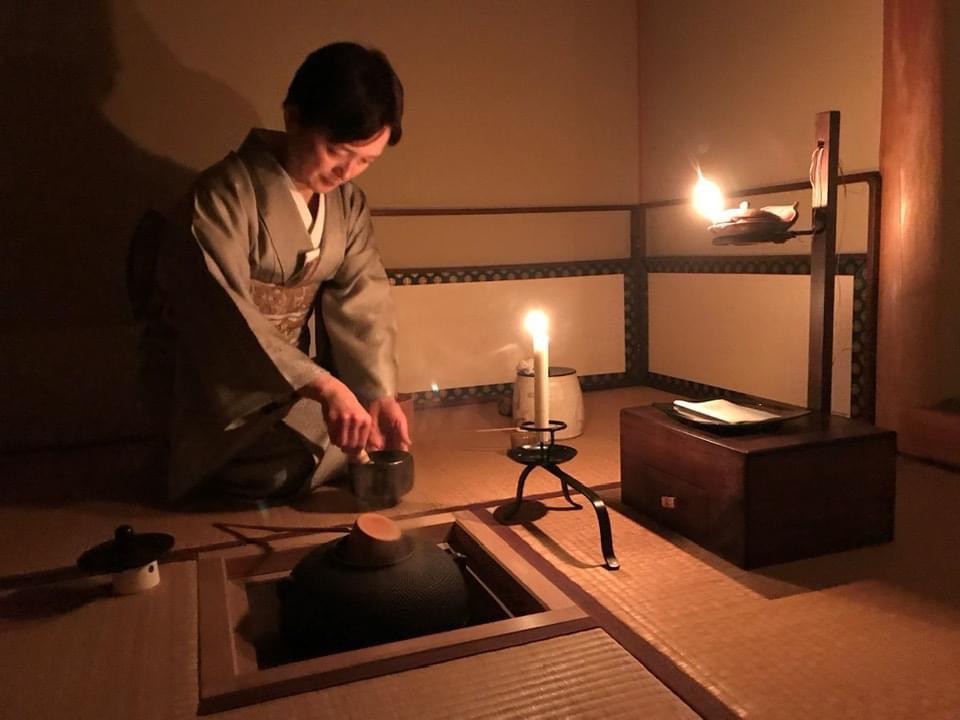
まるで「大和撫子」を体現化されたような高橋恭子さん。
平安時代に生まれたこの「大和撫子」という言葉に、皆さんはどんなイメージが湧きますか?辞書で調べてみると「優美で知的、かつ芯の強さを兼ね備えた女性」と出てきます。
世界に出ると、日本人女性は口数が少ない、意見をいわない、男性を立てるなど、大人しさと奥ゆかしさだけにフォーカスされているように感じることがあります。
しかし、しとやかさ、奥ゆかしさ、清らかさの中に、凛々しさと逞しさがある「大和撫子」はまさに世界に通用する誇る立派な日本人女性の姿だと、恭子さんとの一期一会で改めて感じることができました。
高橋恭子さんの茶道教室にご興味のある方はこちらのWebサイトからご覧いただけます→https://www.hakuhoan-tea-academy.com/about
ジャーナリスト、ライターの仕事のご依頼はこちらのフォームから
ジャーナリスト、インタビュアーやライターのお仕事のご依頼はこちらから。英語での取材、インタビュー、日英訳ともに必要な記事の執筆も承ります。オンラインで世界中の方々へのインタビューが可能です。
The tea room “Hakuhō-an” at her residence in North Vancouver,Yasuko Takahashi, who spreads the culture of Urasenke sado(tea ceremony)in Canada-The ‘Yamato Nadeshiko’ is an image of Japanese womanhood that is proud worldwide-
I received an invitation through an acquaintance in Vancouver whom I met at a kimono dressing class: “There’s a charity tea gathering for the victims of the Noto Peninsula earthquake. Would you like to come wearing kimono?”
I went to North Vancouver and visited “Hakuhō-an,” a tea room created by Yasuko Takahashi, a Urasenke tea ceremony master, at her residence. The exterior of the house had a Western-style taste typical of North Vancouver, and I couldn’t have imagined there would be a tea room in this corner.
One moment, one meeting” in Vancouver
Yasuko Takahashi, the proprietor of “Hakuhō-an,” where tea is meticulously prepared in flawless, beautiful kimono attire, exudes a soft, charming, and elegantly poised demeanor.
She speaks Japanese with exquisite beauty. Furthermore, her confidently explaining the art of tea to my partner in fluent English allowed me to catch a glimpse of her true strength.
Later, I reached out to her requesting an interview, and she graciously allowed me to visit again. During the interview, I had the opportunity to speak with Yasuko Takahashi.
The Japanese garden and tea room “Hakuhō-an” induce an illusion as if you were in Japan
Stepping into the charming Western-style residence, through the large windows of the living room, a beautiful Japanese garden unfolded. It was like entering another world (Japan) with seasonal flowers, stepping stones, and a stone lantern, so enchanting that you could completely forget you were in Vancouver.
Why is the “nijiriguchi” narrow?
As you proceed past the Japanese garden, you’ll come across the tea room “Hakuhō-an.” The entrance to the small tea room, called “nijiriguchi,” is about 66cm in height and 63cm in width, requiring one to bend at the waist to enter.
The introduction of the “nijiriguchi” was pioneered by Sen no Rikyū. During the Sengoku period in which he lived, there was a strong hierarchical relationship. However, the “nijiriguchi” was created to demonstrate that “everyone is equal when in the tea room, regardless of their status.”
This means that even those of high status had to remove their swords and bow their heads to enter.
Seasonal flowers and hanging scrolls displayed in the tea room
When I visited, narcissus and daphne flowers picked from Yasuko’s garden were arranged.
As for the hanging scroll, it featured the phrase “Yanagiwamidori hanawakurenai (柳緑花紅) – “Willow is green, flowers are red.” This phrase depicts the beautiful scenery of spring and serves as a metaphor for how each thing possesses its own unique qualities.
Having a competitive spirit can sometimes lead to personal growth. However, comparing oneself to others can also be stressful. This phrase gently reminds us that such comparisons are unnecessary, offering soothing words of wisdom.
Enjoying Japanese sweets that evoke the arrival of spring and the tea prepared by Yasuko-san
Her graceful movements in preparing tea, the way she enters and exits the tea room, the opening and closing of doors, her manner of speaking, and her overall demeanor—all were elegant, efficient, and devoid of excess. Even the sounds she made while preparing tea were beautiful, leading me to feel as if I were completely immersed in another world.
The view of the garden from the tea room was charming, with the overcast sky typical of Vancouver complementing the red of the camellias.
Unraveling Yasuko Takahashi’s life through an interview
There were countless questions I wanted to ask her, ranging from her journey to tea ceremony to the reasons for coming to Vancouver.
After enjoying tea at her home, we moved to a Japanese restaurant recommended by Yasuko-san.
I wanted to know not only about her as a practitioner of tea ceremony but also about her as a Japanese woman. I had the opportunity to have many conversations, delving into her life and unraveling the reasons behind her captivating personality.
What prompted you to come to Vancouver? And what led to your stay of about 30 years?
Originally from Hiroshima Prefecture, Yasuko-san came to Vancouver nearly 30 years ago as a student to learn English after obtaining her teaching license from the Faculty of Education at Ehime University. Interestingly, it was initially planned for just three months.
Yasuko-san: “It’s unbelievable that it’s been 30 years. Time flies.”
Me: “I initially planned for just one year, and now I’m in my third year, so life is full of surprises, isn’t it?”
Meeting her husband and the birth of their two children
The principal of the school where Yasuko-san attended as a student in Vancouver turned out to be her future husband. Their relationship naturally began after she finished her study and were no longer in a student-teacher dynamic.
About two years into their relationship, they welcomed their first child, followed by the birth of their second son. The elder son lives in Vietnam with his Vietnamese wife, and they have an eight-year-old child. The younger child is currently a university student in Vancouver.
She was such a fan of kimono that she obtained a license for dressing them in Japan, and in Vancouver, she encountered tea ceremony
During her student years, Yasuko-san was so captivated by kimono that she obtained a license for dressing them. Although she had an interest in tea ceremony, she had no prior experience with it in Japan.
The catalyst for her fascination with kimono was her part-time job at a hotel during her student days. Sometimes, she would welcome guests wearing a kimono, which allowed her to experience the charm of kimono firsthand.
Encountering tea ceremony(Sado) in Vancouver, she once again realized the charm of Japanese culture
When she came to Vancouver, she happened to visit the Nitobe Memorial Garden on the UBC campus, where a Urasenke tea gathering was being held. Upon participating, she was immediately drawn to the charm of tea ceremony and reportedly offered to start learning from the teacher on the spot.
Yasuko-san: “My mother also practiced tea ceremony, often wearing kimono at that time. So, Japanese culture has been familiar to me since childhood. However, when you’re young, Japanese culture is often too familiar to appreciate fully, and you tend to become westernized. Leaving Japan allowed me to rediscover the charm of Japanese culture. I’m glad I noticed.”
After mastering tea ceremony in Vancouver for over 15 years, she moved to North Vancouver and created a tea room and Japanese garden at her home
She didn’t build the tea room to open a tea ceremony class. It was after practicing for over 15 years that she received her tea name. About a year after that, she moved to this house, thinking simply that since there was space in the garden, she wanted to make a tea room.
She then commissioned a gardener and a carpenter in the Vancouver area to create this beautiful Japanese garden and tea room.
As word spread that there was a tea room at her home in North Vancouver, there was a growing demand for tea ceremony classes. This led to the current situation for Yasuko-san.
About Yasuko-san’s tea ceremony class
What are the differences between having a tea ceremony in Vancouver and having one in Japan?
Yasuko-san: “In Japan, there’s an overwhelming abundance of items, and many people have refined tastes. When you host a tea ceremony, people often notice how valuable your tea utensils are. Also, during a tea event with meals included, there’s a tendency to pay attention to who the chef is and other details like that.
In Vancouver, there are many items that aren’t readily available, so if they’re not there, you have to make them. Even the utensils I own aren’t necessarily very expensive.
There are many positive aspects to practicing tea ceremony in Vancouver. While there are things that are lacking, they can be supplemented.”
Explaining Japanese culture in English
Yasuko-san’s graceful demonstration of fluently and beautifully explaining the culture of tea in English to my partner prompted me to ask a question.
Me: “When explaining Japanese culture in English, I often find myself struggling for words. How did you improve in this area?”
Yasuko-san: “It’s all about practice. You have to gain experience, explain things in front of large groups of people, and build confidence. And of course, you have to study. It’s impossible to explain something in English that you can’t explain in Japanese, so whenever I have free time, I read books.”
Her family and private life
Apart from tea ceremony, Yasuko-san is also active in skiing, traveling, and jogging in the forests of North Vancouver in the mornings.
As a Japanese woman, mother, and wife, I was curious to learn more about her, so I asked her several questions.
What was the most challenging thing you faced in your life?
Yasuko-san: “Parenting! Since my older child was born, it’s been like dealing with constant rebellion.
I sent him to university in Japan, but I received a call from the school saying, ‘Your child hasn’t been attending classes at all. If this continues, he will fail.’ There was also a time when plates were thrown at me. It was frightening. But having overcome such challenges, I’m now unshakeable no matter what happens.
Now he’s become a wonderful father himself. I think becoming a parent makes you truly appreciate your own parents.”
What makes you happiest?
Yasuko-san: “When I return to Japan and relax in a rustic hot spring. Also, the moment when I finish a day and sink into a bath with bath salts. Basically, I just love soaking in the tub! haha Maybe it’s because I’m a Pisces.”
Me: “That might be why you were drawn to tea ceremony, which also involves hot water!”
Who is your best friend?
Yasuko-san: “My husband. Strictly speaking, he’s not a friend, but we’ve been together for over 30 years. Longer than with my parents. We’re more like comrades at this point.”
Me: “What’s your favorite thing about your husband?”
Yasuko-san: “The thing I appreciate most is that he lets me do what I want. He’s always like, ‘You can tell me about it later.’ haha
Basically, we do our own thing. He can only sit in seiza for 20 seconds, and after all these years, he still doesn’t know how to drink tea properly. haha
But in return, he lets me do as I please. I like that he doesn’t fuss about things. We both do our own thing, but we trust each other.”
One must behave in a manner that reflects well on being Japanese
Yasuko-san: “From the first time I came to Vancouver, I’ve felt that one must conduct themselves in a manner that they wouldn’t be ashamed of as an individual, of course, but also as a Japanese person. It’s like being a representative of Japan. As someone who teaches tea, I try to demonstrate this through my attitude.”
Me: “I can totally relate! My mother once showed me a letter from my grandfather to her during her childhood, sent from a business trip to Germany. One line from that letter, ‘Become a respectable Japanese person who wouldn’t be ashamed even when traveling abroad,’ stuck with me. That’s one of the reasons why I came to Vancouver. I couldn’t forgive myself for feeling awkward and fidgety when facing foreigners and unable to speak English.”
Looking back on life, all the pieces are connected
Yasuko-san: “When you look back, everything is connected, isn’t it? If even one piece had been out of place, I wouldn’t be who I am today. If I hadn’t moved to this house, there wouldn’t be a garden, and if I hadn’t built a tea room, I wouldn’t have become a tea ceremony instructor.”
Me: “I understand. I’m 35 now, and as I’ve gotten older, I’ve had more opportunities to experience that, and it has relieved some of the pressure.”
Yasuko-san: “It’s easier to live life that way, not knowing what will happen next and finding it interesting. When you’re young, you don’t understand because life still seems short, but once you pass 30, and even more so after 50, you understand it even better.”
Yasuko-san’s future goal is?
Yasuko-san: “It’s more about my daily way of living rather than a specific goal. I try not to refuse whenever someone asks me for help. I want to continue this attitude in the future.
And I want to keep doing things that benefit others. I’d like to hold a charity tea event at least once a year. There are always people in need.
Basically, I want to go with the flow of life. By doing so, various interesting opportunities come my way.”
The ‘Yamato Nadeshiko’ is a proud and noble image of Japanese womanhood
Yasuko Takahashi embodies the ‘Yamato Nadeshiko’ as if she were its epitome.
When you hear the term ‘Yamato Nadeshiko,’ which image comes to mind? According to the dictionary, it describes a woman who is elegant, intelligent, and possesses inner strength.
When viewed from an international perspective, Japanese women are sometimes perceived as reserved, quiet, and deferential to men.
However, within the grace, modesty, and purity, there lies a resoluteness and resilience that defines the ‘Yamato Nadeshiko,’ making it a truly admirable image of Japanese womanhood that transcends borders. This was once again felt during my encounter with Yasuko Takahashi.
For those interested in Yasuko Takahashi’s tea ceremony classes, you can find more information on her website here: https://www.hakuhoan-tea-academy.com/about
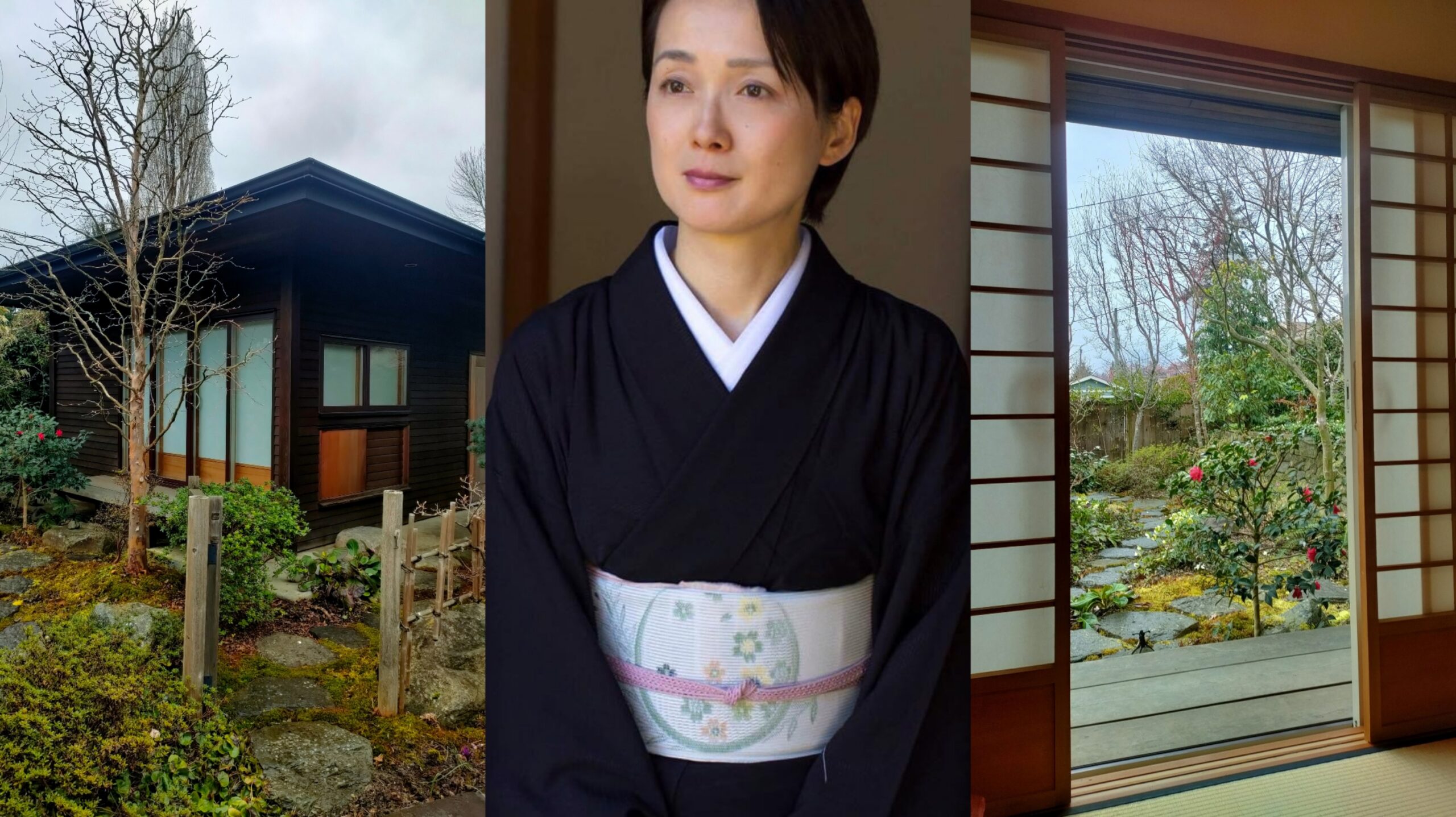
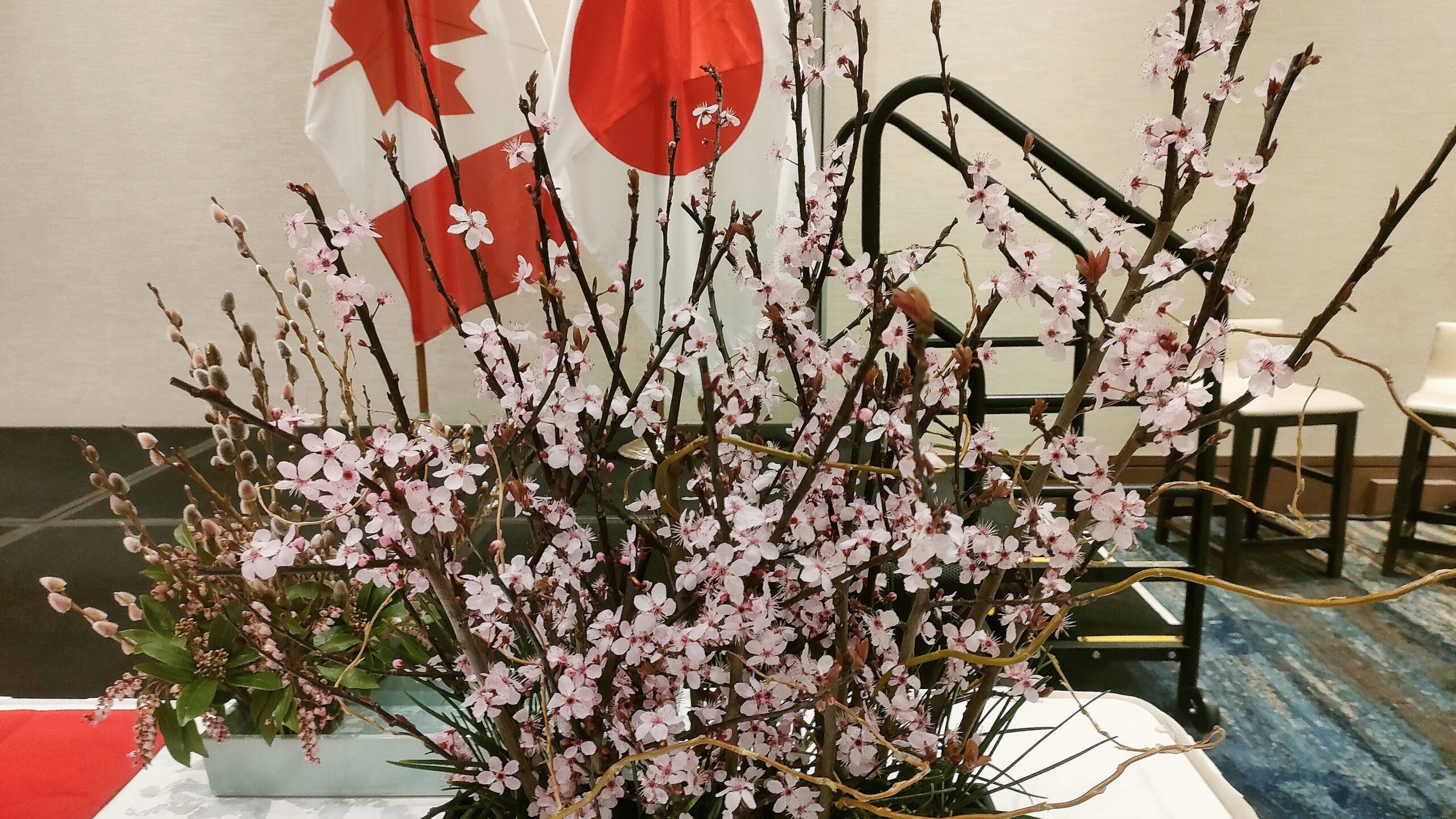
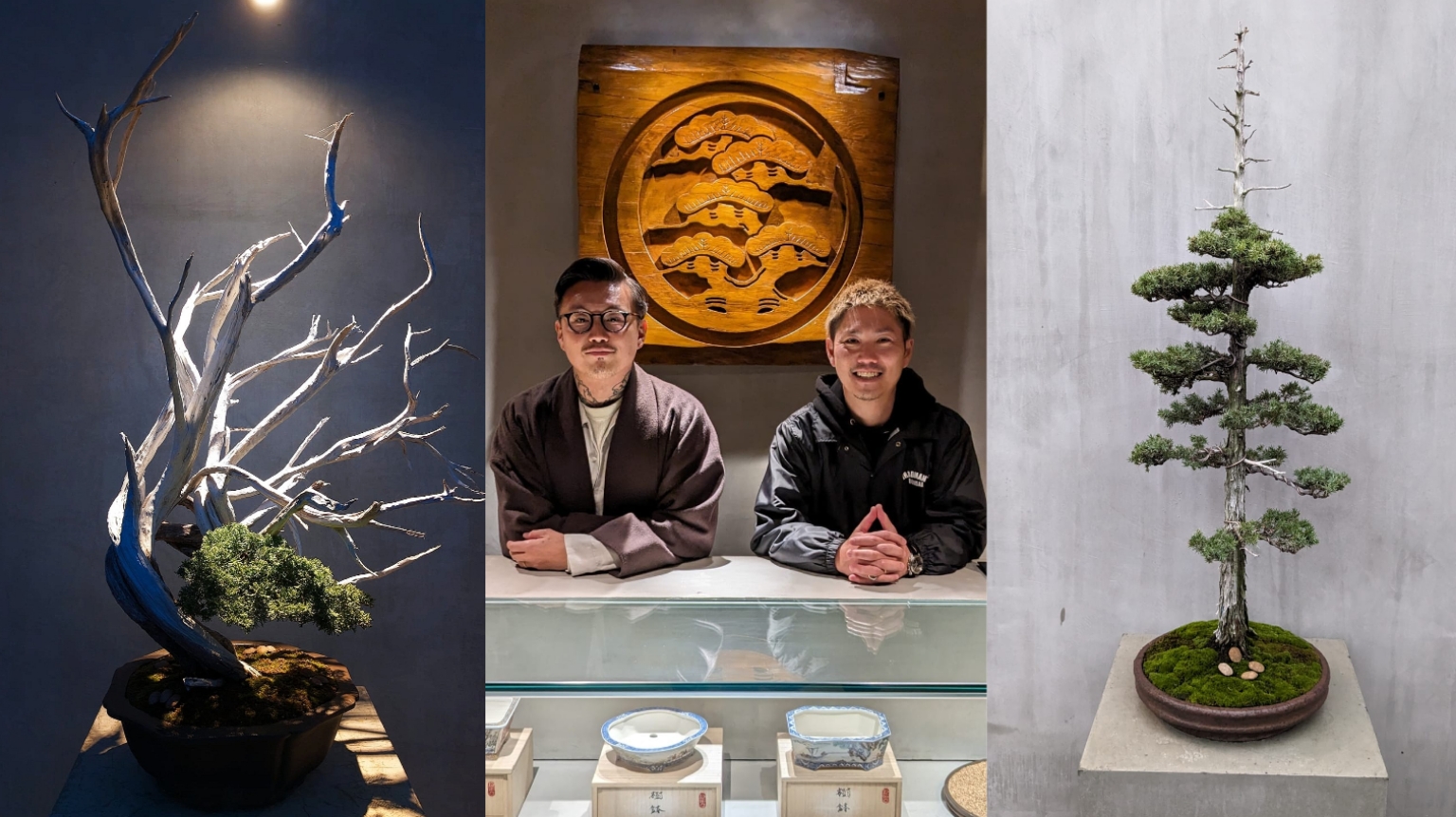
コメント